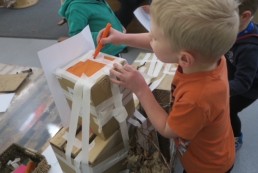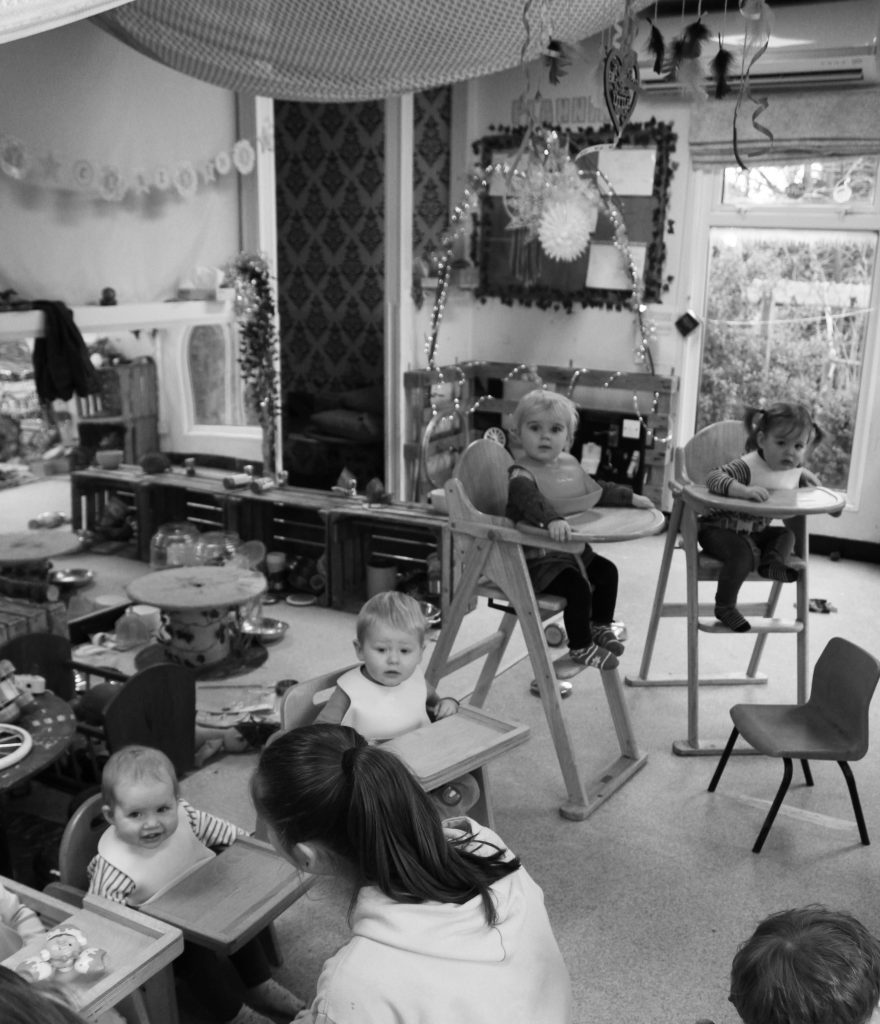Spotlight on...Ladybirds Room
Our ladybirds room is our Pre-School Room, and in fact it isn't a 'room' at all. In 2018 our Pre-School moved from what is now the Toddler room, to become an outdoor setting across many areas.


We have the Mongolian Yurt which is our cosy warm round classroom, the outdoor classroom, the mud area, the Art Studio, the forest school garden and Hunger Hills Woods in its entirety. Every morning the educators, forest school practitioners and atelierista pitch to the children and following this they choose where they want to spend their morning, and then afternoon. So let's meet the team who run our 3 and 4 year old areas.
Lisa- Pre-School Manager

For 18 years this year I've been part of the Inspirations team, starting straight from leaving school as an Apprentice and gaining my Level 3 Qualification. I've worked in both the Toddler and Preschool rooms, spending around 7 years as a leader in the Toddler room before becoming Preschool Manager over a year ago. I find immense joy in engaging with the children during their play. It's incredibly rewarding to see them grow and prepare for school.I also think it’s such a privilege parents are happy to go to work, knowing their children are so happy and safe in our care. I am passionate about building a strong team of practitioners to create the best outcomes possible for the children.
Ellie-Pre-School Manager

I am one of the Preschool managers working Wednesdays and Thursdays. I have worked at Inspirations since 2018 where I started as an Apprentice. I then worked my way up with the support of our team and of course the children at Inspirations. I love watching the children grow and flourish during their time in the Preschool room and it gives me so much pride when they leave us ready to go to school. The thing I enjoy the most about my job is watching the children learn through exploration and wanting to share their achievements and news with us!
Phoebe- Deputy Room Leader

I have worked at Inspirations for almost 4 years, I started as an Apprentice when I was 18 after surviving lockdown (just about)! Since a young age I have always wanted to work with children as I enjoy being able to help others and believe I am a positive, fun, firm but fair role model to not only children but staff too. Fun fact about me is I am a home owner; I live with my brother Cameron and two cats Willow and Luna. Before Christmas I suddenly lost my mum. This completely turned my life upside down. Since losing her I have made it my life’s goal to make this world a better place and I want to help others in every way possible. Her passion was cooking, now I continue this at Pre-school as we cook and bake daily! At a mass dedicated to my mum a priest said food banks were running low, I saw this as sign, hence why I was so passionate about raising for the food banks the pre-schools helped me take.
Katrin- Apprentice

I am the Preschool apprentice and I have been working at Inspirations for almost 2 years after moving here from South Wales. I love being outdoors and appreciating nature, and I enjoy sharing these experiences with the children and encouraging their love of our environment.
Eleanor- Educator

I have been at Inspirations for three years working in the preschool room. I studied childcare since the age of sixteen and am currently level six qualified. I love working with this age and enjoy the fun conversations we can have throughout the day. I enjoy taking the children out into the community and love to see how they get involved with projects such as visiting and helping at the food bank. I have recently returned to work after maternity leave with my little boy who is now one. He is currently in the baby room which I find comforting knowing that he is here with me and being looked after by the wonderful Hedgehogs team. I enjoy seeing the setting as a practitioner and now also as a parent.
Natalie-Educator

I've been part of the Inspirations team since April 2022. I absolutely love working with children. One of my favourite parts of the job is engaging in conversations with them and sharing ideas to make their playtime even more exciting and enriching. I also enjoy exploring feelings and emotions with the children, hearing about their experiences, what they enjoy doing at home, and chatting about our families. It's incredibly rewarding to connect with the children on such a personal level and help them grow and learn in a supportive environment.
Zoe- Forest School

I embarked on my adventure with Inspirations Nurseries in October 2015, beginning in the toddler room. Since then, I've had the opportunity to work in all the different rooms. Four years ago, I transitioned to the Pre-School room, where my passion for the outdoors grew, leading me to explore working in Forest School. Engaging with the natural environment on a daily basis fills me with joy. I thoroughly enjoy sharing my knowledge with the children and witnessing the remarkable resilience they display when overcoming challenges. Observing their learning process is particularly rewarding, especially during activities like fungi spotting. The collective excitement we experience when discovering various fungi adds a special layer of satisfaction to the entire outdoor experience. Beyond the fulfilling aspect of watching children grow, what has kept me here at Inspirations for so long is the profound connection with the people here. The anticipation of work is not just about the tasks at hand but the genuine pleasure of being part of a supportive and great team at Inspirations.
Rachel- Forest School

I've worked at Inspirations for around 4 years starting in the Yurt as a Level 3 Early Years Educator and progressing to joint lead with Zoe, as Level Forest School Practitioners. I completed my training in September after studying for a year and completing 2 weeks practical training which involved tool work, fire lays, cooking, climbing, risky play and the associated health and safety around these areas. It also involved "seed setting" for imaginative play, shelter building, learning theories and meeting children's needs. I enjoy doing ID work with the children and listening to them share the things that they have learnt at forest school such as naming fungi, plants and knowing which ones they can forage for. I also enjoy seeing them enjoy their time in the woodlands developing their care and concern for the world around them; plants animals and the environment.
Nathalie- Atelierisa

Hi I’m Nathalie from the Art Studio, although fairly recently back from maternity leave I’ve worked at Inspirations since 2010, shortly after getting my BA Honours in Photography and Video at De Montford University. I originally started as maternity cover in the Baby Room before leaving to run the art department at a summer camp in Maine, USA for 4 summers. I returned to Inspirations after backpacking each year and nannying for a professional footballer in Germany. Inspirations always had me back and so over the years I have worked in all the rooms, until 2018 when the Art Studio was built and I was hired as the Atelierista. I always said I would never be able to find a job where I could combine my love for children, art, sewing, painting, pottery, ukulele and photography, but here we are; the job does exist! I'm often blown away by the capabilities of our children when given the space, time and resources to create anything out of nothing.


Creative Projects in Adel
Our Atelierista Julie over at Adel Inspirations works closely with the children following their interests through child led project based learning. So this week for our blog are taking a look at their most recent project.
The Foods and Shop Project
The children first became interested in food when we started creating collages out of food magazines. Beyond refining their fine motor skills, the food collages sparked up conversations about food, diet and flavours. “My favourite fruit is watermelon”, “Last time we were baking we used a bit too much sugar.” This was the starting point in which our project began.
Even when collaging, each child had their own unique approach when it came to cutting, arranging and selecting pieces. Some focused on categorising different types of food, whilst others gravitated towards certain colour palettes. For some of the older children, they took interest in letters found in the magazines and were able to arrange names and other words with support.

Based on the different conversations about the flavours found in food, the project flowed from collage to spices and clay. The spices allowed the children to utilise their senses, smelling and using touch to figure out how to integrate the spice into their clay creations. They even walked around the room with different spices, inviting other children to smell and make associations. “This one smells like chocolate”, “It smells like oranges!”. During this process, some children also asked where the spices were from. This led us to talk about where our food comes from, and one of those familiar places would be shops.

With the idea of shops in mind, the children thought it would be a good idea to build a food shop together using cardboard boxes and tape. Before beginning construction, the children shared their own shopping experiences with each other. We also used videos and photographs to inform our plan for the shop. This discussion opened up new vocabulary associated with shops, such as ‘cashier’, ‘cash register’ or ‘scanning’. The children ended up deciding that a fridge, shelf and trolley would be the first things to build. Aside from building fine motor skills and engaging in team work, the process of constructing encouraged problem solving. The children discussed and made decisions together about the best way to arrange and construct, sometimes using trial and error to see what would work.

When the shop’s components were built, this area became open for different types of role play. Some children role played as waiters and customers in the cafe area, whilst other children role played as cashiers, scanning products on the checkout machine we had made. This opened up opportunities for maths, where the children bought items and paid with loose parts, counting the correct amounts. Role play allowed for them to explore different roles in society, integrate their own experiences and engage in literacy and maths through play.


The project is yet to be completed, but there are so many directions in which it could grow and expand. Rather than having a strict and set curriculum, following the interests of the children created deeply engaged and proactive learners. With the hundred languages available at our disposal, the opportunities for learning are endless.
Julie
Spotlight on...Butterflies Room
The Butterfly Room
The Butterfly Room is our second baby room, right next door to our other baby room Hedgehogs. Originally the Butterly Room was our Toddler Room, until 2018 when we transitioned to a Forest School. This transition meant we moved our Pre-schoolers to an outdoor provision, meaning the Toddlers could move into the much bigger Pre-school room therefore opening up space for a second Baby room- Our Butterfly Room.



 T
T
Both baby rooms open out into the same garden and outdoor area meaning the children can mingle when playing outside. There are little differences between to the two rooms other than staff, and instead of the climbing bridge and slide it has a sensory light room. So let's meet the amazing team that make this room an exciting, safe and loving room for your baby to join Inspirations.
Let's meet the team
Maddie

Hey, my name is Maddie and I’ve worked at Inspirations since April 2023. I started as the Deputy Room Leader in the Hedgehog room. In December 2023, I was promoted to Room Leader of the Butterflies room. I really enjoy working at Inspirations, it's a great atmosphere. My favourite thing about working with children, is watching how they progress at different speeds, and I really enjoy getting involved in messy play with the children.
Holly

Hi, my name is Holly, I am the Deputy Room Leader of Butterflies. I have been here since December 2019. I started as an apprentice in the hedgehog room and then I worked my way up to become Deputy in the Butterflies room. I love working with the babies and seeing them grow and watching them achieve their goals. I love the fact we build such a close bond with the parents and their children.
Ashrya

I’m Ashrya, I am the room apprentice and I have been working here for over 6 months doing my Level 3 in childcare.
I studied at Leeds Arts University specialising in fine art and sculpture, I love working with children, learning their interests and being hands-on. I like doing creative activities with the children and watching their development and their personalities grow in the short time we get to spend with them in our room.
It’s such a pleasure to be able to work with under 2s, my favourite thing about my job is being able to work together with parents to support their child’s learning.
Lynne

I'm Lynne, I started working at inspirations in 2019 as an Early Years Educator. I enjoy helping and encouraging children to reach their developmental milestones and seeing them progress through the various activities we do.
Over the coming weeks we will focus on the staff from each room, finding out how long they have been with us and what they love most about working with children. Why not look through this blog at home with your children? This is a great way to promote discussion for the more vocal age groups, and for familiarity with the younger ones.
Embarking on an Eco-School Journey
In today's world, it is crucial for educational institutions to cultivate a sense of environmental responsibility among young minds. Inspirations Nurseries and Forest Schools have a unique opportunity to install a love for nature and sustainability in children from an early age. By focusing on key areas such as waste management, biodiversity, and litter reduction, we can create a positive impact on both their immediate surroundings and the wider community.

In this blog, we will explore the initiatives we have taken so far and our plans for future projects as we embark on our eco-school journey. For our first 3 topics we have chosen waste, biodiversity,and litter.

Waste Management:
One of the essential aspects of becoming an eco-school is effectively managing waste. Our nursery school has already implemented exciting projects like the "Battery Hunt" to raise awareness about proper battery disposal. This initiative not only educates children about the importance of recycling but also encourages them to actively participate in collecting and disposing of hazardous waste.
Building upon this success, our next project is to establish a community litter pick. We will learn about different types of waste, their impact on the environment, and innovative ways to reduce, reuse, and recycle. By involving the local community, we aim to create a sustainable waste management system that fosters a sense of ownership and responsibility among us all.
Biodiversity:
Preserving and promoting biodiversity is another crucial aspect of our eco-school journey. We believe that connecting children with nature from an early age helps them develop a deep appreciation for the environment and its inhabitants. To achieve this, our nursery has already participated in initiatives like the RSPB's birdwatch, encouraging children to observe and learn about local bird species.
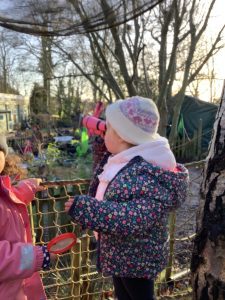
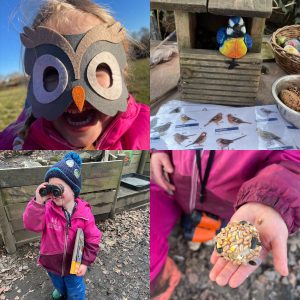
Moving forward, we will focus on creating a biodiversity-rich environment within our premises. We plan to establish wildlife-friendly habitats such as bird boxes, bug hotels, and butterfly gardens. These initiatives will not only provide a haven for local wildlife but also serve as valuable educational resources for our children. By nurturing biodiversity, we aim to create a harmonious ecosystem that fosters learning, curiosity, and a lifelong love for nature.
Litter Reduction:
Litter is a common environmental issue that affects both urban and rural areas.
Inspirations Nurseries and Forest are committed to tackling this problem head-on. In addition to the community litter pick, we are also committed to reducingsingle-use plastic consumption by opting for plant-based alternatives to dairy where we can, refilling bottles, suchas cleaning products, hand soap and washing powder.
As part of our ongoing efforts, we will be launching a community composting project. This project aims to divert organic waste from landfills and transform it into nutrient-rich compost. By involving the local community, we hope to raise awareness about the benefits of composting and encourage sustainable practices at home and in the wider community.

By actively engaging in waste management, biodiversity conservation, and litter reduction initiatives, our nursery is paving the way for a greener and more sustainable future. Through these projects, children not only learn about environmental issues but also develop a sense of responsibility, empathy, and stewardship towards the planet. As we continue our eco-school journey, we hope to inspire other nurseries and forest schools to join us in creating a better world for generations to come.
Tara
Meaningful Art
At Inspirations Nurseries all of our rooms have a focus on creativity, and our Pre-School room have access to our Reggio Emilia Inspired Art Studio, where the children and the Atelierista follow interests to develop and learn through all forms of expressive art. But what should children's art look like? And what makes meaningful art?
I remember as a child being given a template to colour in at school, which is a lovely pastime, but looking back now it feels so hollow. Sure we were given the freedom to choose whatever colour we wanted, and the challenge of trying to stay within the lines, but are there any meaningful moments created here? I used to spend my weekends creating dolls houses from cereal boxes, recording my own radio shows and even creating sculptures from the babybell cheese wax. It was in these moments of creating something out of nothing where meaningful moment were made.
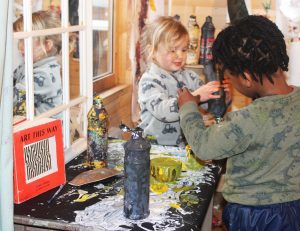

Children express themselves in so many ways, we call this the 100 languages of learning. When it comes to children's creativity, the adult can sometimes get in the way of the children's full potential, and sometimes the fear of 'mess' is a huge barrier at home. This is why the Art Studio is that place for children to create using their whole bodies, their senses, their hands and their voices.
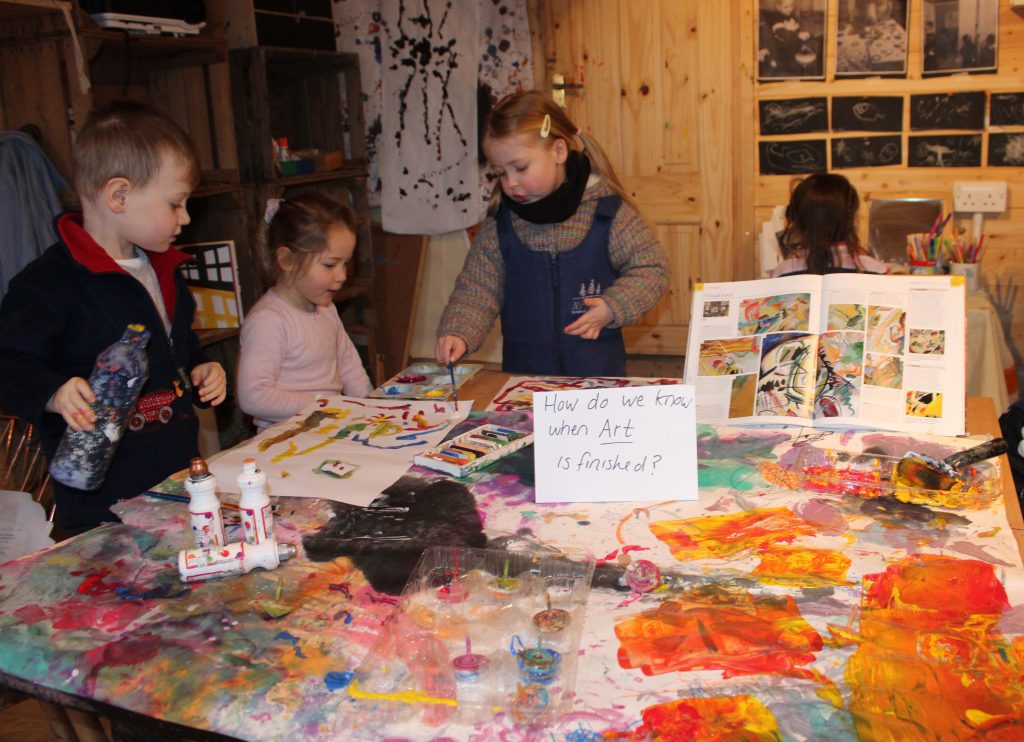
What makes meaningful Art?
Well, to put it simply, meaningful art happens when the child is fully immersed in the process. We pin too much expectation on what children's art should look like, and put too much focus on a finished product to bring home and stick on our fridge. If we remove that preconceived idea of what a child's creation should look like, then the barriers come down and imagination is unlocked and learning really starts to happen. Art, much like learning is a process, a chance for them to test ideas out, experiment with colour, embrace mistakes, learn the properties of materials, and sure, none of this can happen without mess!



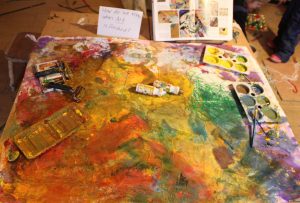

Removing our preconceived ideas of the process or end result doesn't mean the activity is without intent. At Inspirations our activities are open ended, but there's always intent behind it. When setting up any activity, as the educators we ask our selves 'what do we intend them to learn?' and 'how will we implement this?'
Art is not about conforming, the very essence of art is to be free and explore. You may have noticed at Inspirations we don't send children home at christmas with crafts, we don't line our children up in a production line to make valentines cards with a template thought up by an adult. This is because we always put our children at the centre of their own learning, it is their ideas that are to be tried and tested, their mistakes that are learnt from, and their experiments that are creating the blueprint to their future brain connections. When we provide the space, the time and the materials and follow their lead the results are magical, and the process leaves a lasting impression.

-Nathalie
Spot light on...
...The 'Hedgehog Room' Staff
This week we take you to our Baby Room; the original Baby Room from day 1, down at the very bottom of the corridor.
There are 4 dedicated regular members of staff who help make that room what it is. They are the Nursery Rhyme Gurus, the Story Tellers, the Dancing Queens, Messy Play enablers and full time feeders, cleaners and nappy changers, and all with a smile on their faces.
So let's meet the team

I’m Sophie the room leader of the Hedgehogs room, I started at Inspirations in May 2021 as the Deputy, before taking over as room leader in September 2022. I enjoy getting involved with messy activities and splashing in puddles with the children. One thing I love about working with the babies is watching their development progress so rapidly and seeing them turn into independent, confident toddlers as they progress through the nursery.

I'm Alice, I started working in the Hedgehogs room after working as a Crèche worker in a local Leisure Gym, I recently became deputy. I enjoy being energetic with the children including singing, dancing and doing action songs.

I started working in the Hedgehog's room in April 2023, I’ve worked with children for over 20 years, I enjoy watching and encouraging the children to hit those important milestones. I enjoy spending time in the outdoor learning environment watching the children experience the different seasons.

I’m Gypsy the Apprentice, I stared at Inspirations in August 2023. I enjoy reading to the children and playing with the children in the garden. One thing I enjoy about working with the babies is how energetic they are and how the simplest things can make them laugh.
Over the coming weeks we will focus on the staff of each room one by one, finding out how long they have been with us and what they love most about working with children. Why not look through this blog at home with your children? This is a great way to encourage familiarity or discussion for the more vocal age groups.
Inspirations Daily Routines
A day in the life of...
We pride ourselves on being a Reggio Emilia Inspired, Child- Led nursery, with creativity at the centre of our learning. But of course child-led doesn't mean we are without structure to the day. Structure gives children stability and a sense of security, routine helps children feel safe and secure in their environment be it at home or at nursery. It takes a happy and settled child to be confident learners and explores, and routine helps with settling in to new environments. We use tapestry to give you updates on specific activities at Inspirations, but if you've ever wondered exactly how the day is structured for your little ones then look no further.
Baby Rooms- Hedgehogs and Butterflies
In the baby rooms the key worker matches your babies routine at home as much as possible, but the general structure of the day is as follows-
- 8.30 Breakfast
- 9.00 Nappies
- 9.30 Morning Activity- (This varies between painting, water play, outdoor play or messy play. The youngest of the room take this time for their morning nap whilst some are outside.)
- 11.30 Lunch is served, chopped up or blended for the younger ones.
- Singing time in the soft area of the room whilst lunch is cleaned up
- 12.00 Nappies
- 1.00 Sleep times begin- Lights off and lullaby’s on
- Afternoon Activities and outdoor play
- 3.30 Tea Time
- 4.00 Nappies
- Free play and Home time
Toddler Room- HoneyBees
- 7.30- Welcome the children/Activities set up
- 8.30 Breakfast
- 9.00 Group Time- Story/Yoga and choosing
- 11.00 Nappy time.
- 11.30 Lunch Sessions Begin
- 12.00 Sleep Time on the Mezzanine Begins
- 2.00 Free flow play
- 3.00 Nappies
- 3.15 Tidy Up time and 2 group time
- 3.30 Tea Time
- 4-6.00 Afternoon Actives and Home Time
Pre-School- Ladybirds
- 7.30-8.30 Morning Activities across yurt, outdoor classroom and the mud
- 8.30 Breakfast
- 9.00 Carpet time in 2 Groups /Wake up shake up
- 9.20 Choosing Time and Morning sessions begin (Yurt/Outdoor classroom, Art Studio or Forest School)
- 11.30- Art Studio Returns for Session 1 Lunch in Dining Room
- 12.00- Forest School Returns for Session 2 Lunch in Yurt and Dinning Room
- 12.30 Free Play
- 1.00 Choosing Time for Afternoon Sessions (Yurt/Art Studio/Forest School)
- 3.00 Art Studio and Forest School Return
- 3.30- Tea Time
- 4-6 Afternoon Activities and Free Play on sight followed by home time.



We are passionate about giving children the best possible start to life, and our nursery rooms and routines are structured to help your children flourish, gain independence and gain the tools and life skills to help them succeed in life. As we round up another wonderful year we want to thank you all as parents, carers and children of our amazing Inspirations Community.
2024 marks 20 years of being a nursery, so we look forward to celebrating with you all later in the New Year. In the mean time we wish you all a wonderful Christmas and New Year.
Nathalie
Adel Inspirations- Before and After School Club
At Adel Inspirations we are a Reggio Emilia inspired setting; our rooms are equipped with natural, up-cycled and recycled resources. Children of all ages explore and investigate unusual items, build and construct with sensory materials and use our real size home kitchen area for role play. We have up-cycled cable reels to use with our wooden cars, trains and animals, along with a fully furnish-able small world house and people. We have opportunities for maths and literacy in all areas as well as a loose parts maths area and a cosy quiet book corner. Inspiration’s creative areas have a wide variety of art resources, clay, paints, pastels, scissors, sticking collage materials, loose parts, colouring pencils, felt tips and paper.
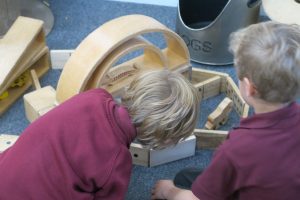
Our Breakfast club has a calm relaxed atmosphere with friendly welcoming staff. Your children can play with all our resources, including art and crafts and choose what they would like to eat from a wide range of cereal, porridge, and toast for £6per morning.

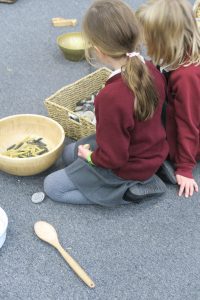
After school club at Inspirations is also staffed with friendly, qualified and experienced practitioners, all with up-to-date DBS checks, first-aid and safeguarding training. We offer a light tea consisting of meals such as beans on toast, wraps, sandwiches, soup and bread and salads.
Our children can choose to play outdoors with our sports equipment, including cricket, football, hula hoops, and tennis. They enjoy having access to the outdoor water tap with buckets and paint brushes, the mud kitchen and sand hut, tarpaulin for den building and hammocks, and can also use the school playground and field. Inside, children play with all our resources, including creative materials, every evening. Our Atelierista (art teacher), Julie, now plans and sets up activities daily for our after-school club and stays until 6pm on a Thursday to work with the children on developing creative skills and techniques using a range of materials such as, clay, Papier-mâché, powder paints, models and natural resources. Therefore if your child enjoys expressing their creativity within a tranquil atmosphere, we can offer this for £12 per session to 6pm.


We have availability Monday to Friday to 6pm. Please email
deborah@inspirationsnurseries.co.uk or phone 0113 2612262 to
book or for more information.
What's On-Christmas in Leeds
Child Friendly Leeds
Leeds has just celebrated 10 years of being a child friendly city with His Majesty the King in attendance to mark the occasion. There are several partners across Leeds working together to create better outcomes for children and young people in Leeds. The Child Friendly Leeds team are responsible for coordinating some of the key work strands that support our citywide ambition to be Child Friendly Leeds. These include communications, events, ambassador engagement, play and enrichment activities and opportunities. They work in partnership with teams and organisations across the city, helping develop connections and partnerships that contribute
towards the outcomes of the Leeds children and young people’s plan and Child Friendly Leeds Wishes.
One of the wishes the child friendly team have, is that children have safe spaces to play, hang out and have fun. Article 31 of the United Nations Convention on The Rights of the Child (UNCRC) states that children have the right to have rest and leisure, including playing and recreational activities. Play is a vital part of healthy development for children and something we have identified at Inspirations too.
Stay in the loop this Christmas
The Child friendly team create a ‘Families’ catalogue every few months to showcase everything that’s going on in Leeds for those months. Included is an educational section, festive events, local news and even Christmas food ideas in November/December. Follow the link below to see this seasons addition and why not sign up to receive your free copy.
https://issuu.com/familiesonline/docs/fleedsnd23print

Ice Rink at White Rose centre- One I am very excited about is the ice rink opening at the White Rose centre, where they are advertising parent and toddler or quiet sessions. Ice skating is quite an adventurous sport; it requires focus, dedication, and discipline. It also helps with developing concentration skills, as well as being a good leg strengthening workout.
Christmas Markets- You may have seen the Christmas markets are spread across the city this year. Traditional Christmas Markets will be making use of different spaces in the city, which includes the annual market at
Millennium square where they will be hosting ‘winter magic’ from 24th November – 31st December. Expect another ice rink, Bavarian style market stalls and a children’s festive themed funfair featuring the ‘30 metre high Starflyer’ and illuminated wheel of Light. The markets will be open:
Monday to Wednesday 10am-7pm
Thursdays to Saturday- 10am- 9pm
Sundays- 10-6pm

Nutcracker Trail- As part of the Christmas markets, Leeds are hosting a ‘Nutcracker Trail’. You can collect your trail map from the Leeds Christmas markets office located in the corn exchange Christmas chalets. Locate
the nutcrackers around Leeds to be in with the chance of winning a voucher! Can you find them all to and solve the magic Christmas word?
Theatre- Between the Carriage Works and the Playhouse there are some lovely productions showing at the theatres; one of which our preschoolers are going to on the 18th December.
https://leeds-list.com/culture/the-pantomimes-christmas-shows-in-leeds-you-wont-want-to-miss/
Horsforth Christmas Lights Switch on is happening this Saturday 2nd December at 5pm, with choirs, live music, dj's and markets from 12pm- 7pm

The Farsley Christmas lights switch on is happening tomorrow night, Wednesday 29th. For other festive markets and choirs here's the link-
https://www.visitleeds.co.uk/winter-season/christmas-markets/
Of course, there’s also the big man himself that everyone wants to see. He will be located at lots of different places across Leeds, that may require booking, please check first. There is an opportunity to write to him to let him know your wishes for this year. You can send your letter to arrive by 30th November to:
Santa,
Santa’s Grotto,
Reindeerland,
XM4 5HQ.
Make sure you include your name and address inside and remember a stamp on your envelope to ensure it gets to him and Santa should reply!
For the adults, there are also festive brunch ideas and lists where all the festive food and drinks are. Including the tipis which will provide the ‘best hot chocolates’ and cosiest spot by the fire under shelter.
Let us know what you get up to by adding to your child’s tapestry journals! The children love sharing this with their friends and the adults at nursery. The older children can tell us more about their always experiences and are really excited to show us what they get up to when they have that quality time with family.
-Kayleigh
Exploring Nature's Classroom
The Benefits of Forest School for Preschoolers
In an age where technology dominates many aspects of our lives, the concept of Forest School offers
a breath of fresh air, literally. Inspirations Forest School for preschoolers is a unique and innovative
educational approach that takes learning beyond the walls of a traditional nursery and into the heart
of nature. In this blog, we'll explore what Forest School is, its benefits for preschool children, and
why it's gaining popularity around the world.

What is Forest School?
Forest School is an educational approach that originated in Scandinavia in the 1950s and has been
steadily gaining traction worldwide. The primary goal of Forest School is to foster a deep connection
between children and nature, instilling in them a sense of curiosity, respect, and love for the
environment. Unlike traditional schools and nurseries, Forest School takes place outdoors, often in
forests, woodlands, or natural settings.



Nature Connection: One of the most significant benefits of Forest School is the profound connection
children develop with the natural world. Preschoolers are encouraged to explore, observe, and
interact with the environment, which helps them develop a sense of wonder and respect for the
earth.
Physical Health: Spending time outdoors in a natural setting encourages physical activity.
Preschoolers can run, jump, climb, and engage in other physical activities that promote motor skills
development, strength, and coordination. They experience whole body learning, building neuron
pathways through whole body connections.
Emotional Well-being: Nature has a calming and soothing effect on children. Forest School activities
often include mindfulness and relaxation exercises that help children manage stress and anxiety. The
outdoors also provides a space for emotional expression and self-regulation.
Social Skills: Interacting with peers in a natural environment promotes teamwork, cooperation, and
social skills. Children learn to communicate, share, and problem-solve while engaging in nature-
based activities.

Cognitive Development: Forest School promotes hands-on learning, sparking children's curiosity and
critical thinking skills. They observe plants and animals, explore scientific concepts, and develop a
better understanding of the world around them.
Creativity and Imagination: The natural world serves as a limitless source of inspiration for creativity
and imagination. Children can build forts, create nature-based art, and invent their games, fostering
their creativity.
Environmental benefits: Forest School encourages a sense of responsibility and respect for the
environment. Children learn about conservation, sustainability, and the importance of protecting the
natural world for future generations.
Independence and Resilience: Forest School promotes self-reliance as children learn to make
decisions and solve problems in an outdoor setting. They also develop resilience by facing and
overcoming challenges that nature presents.
Sensory Development: Nature provides a rich sensory experience. Preschoolers engage their senses
by touching leaves, listening to bird songs, and smelling flowers. These experiences enhance sensory
development.
Long-lasting Memories: The memories created in a natural environment often become cherished
childhood memories. These positive experiences can influence a child's relationship with nature
throughout their life.





Inspirations nurseries believe that Forest School for preschoolers is more than just an educational
approach; it's a transformative experience that fosters a deep and lasting connection between
children and the natural world. By providing a holistic and hands-on learning environment, Forest
School helps preschoolers develop physically, emotionally, socially, and intellectually. The benefits
are numerous, and the memories created in these natural classrooms can shape a child's lifelong
relationship with the environment. Forest School is an inspiring way to give children a meaningful
start on their journey of learning and environmental awareness along with our Reggio Emilia inspired
learning approach within our nursery settings.
Deborah and Becky
Adel Inspirations


